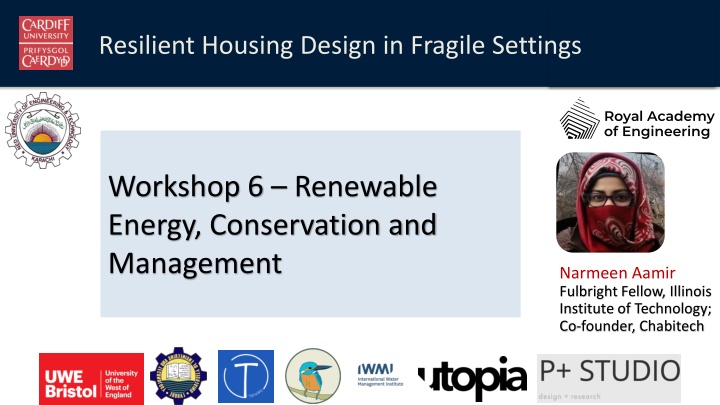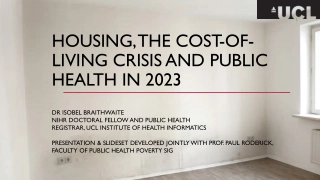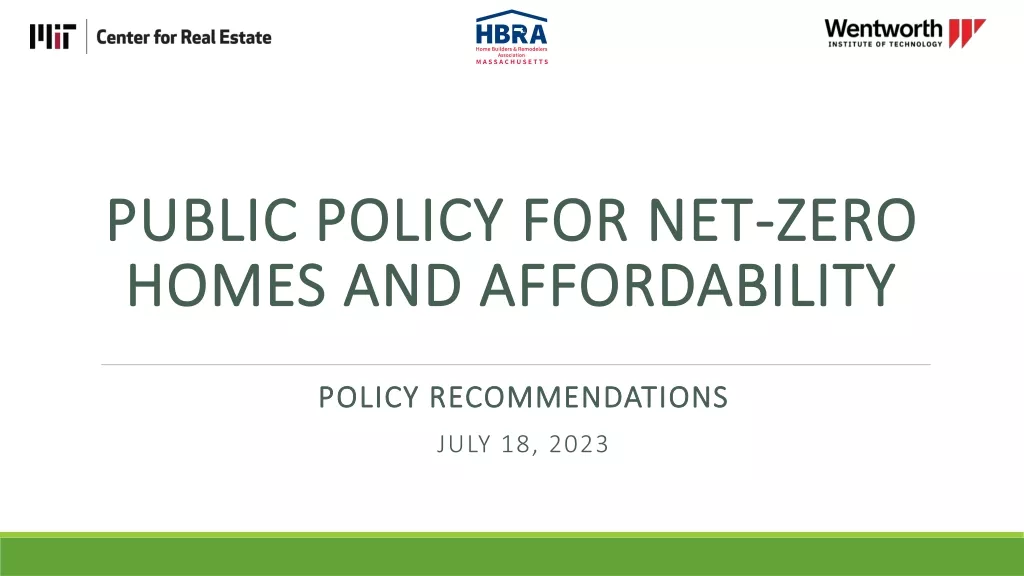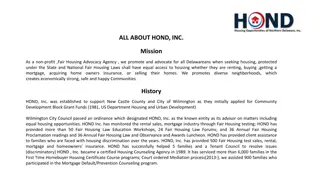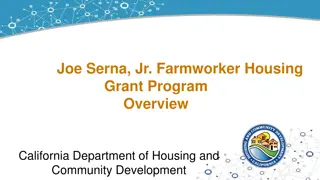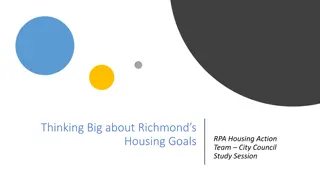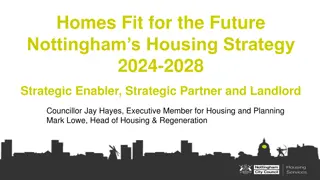Sustainable Housing Design: A Zero Energy Approach for Resilient Living
Explore the concepts of Zero Energy Housing (ZEH), focusing on renewable energy sources, energy conservation, and management techniques. Learn about the benefits of ZEH, the strategic design approach, and practical solutions like energy-efficient lighting and solar heating for efficient, sustainable living.
Download Presentation

Please find below an Image/Link to download the presentation.
The content on the website is provided AS IS for your information and personal use only. It may not be sold, licensed, or shared on other websites without obtaining consent from the author.If you encounter any issues during the download, it is possible that the publisher has removed the file from their server.
You are allowed to download the files provided on this website for personal or commercial use, subject to the condition that they are used lawfully. All files are the property of their respective owners.
The content on the website is provided AS IS for your information and personal use only. It may not be sold, licensed, or shared on other websites without obtaining consent from the author.
E N D
Presentation Transcript
Resilient Housing Design in Fragile Settings Workshop 6 Renewable Energy, Conservation and Management Narmeen Aamir Fulbright Fellow, Illinois Institute of Technology; Co-founder, Chabitech
What is Zero Energy House? Goal: produce as much energy, through renewable sources, as the home consumes in a year Net zero utility bills.
What is the need for it? Reduction in green house emissions Self-reliance in energy Lesser load on the grids Stability of over all system.
Strategical Approach Choose an appropriate site (ample solar energy/wind energy) Daylight saving techniques Energy efficient lighting Energy efficient appliances Solar heating Insulation Add-ons PV panels
Daylight Savings Remember the ancient times Daylight discussed in the holy scripture (Al-Kahf) Daylight saving time EnergyPlus software has the capability to analyze daylight and energy flow in buildings Roof domes affect the energy required for lighting, heating and cooling Use of mirrors Choosing colors for the rooms https://ieeexplore.ieee.org/document/7062436 https://ieeexplore.ieee.org/document/7346975
Energy Efficient Lighting Light emitting diodes (LEDs), Compact fluorescent light (CFLs) Choose appropriate Lux levels (DiaLUX) Soil lamps?
Solar Heating Solar hot water heater Collects heat as the sun shines through south-facing windows and retains it in materials that store heat, known as thermal mass. What about sunlight in summers? Indirect circulation systems Pumps circulate a non-freezing, heat transfer fluid through the collectors and a heat exchanger. This heats the water that then flows into the home. They are popular in climates prone to freezing temperatures.
Good Insulation Isolating the outer environment from inside Lower effort required to maintain desired temperature Lesser impact of heat/cold from outside
Energy Management Running appliances at off-peak hours straightening the curve The Home Energy Manager is designed to control and optimize on-site energy generation and consumption, such as by running the dishwasher or clothes dryer at times when the solar panels are operating, and not during peak times
Energy Efficient Appliances Tier 3,4 CEE Advanced Tier Rating Energy Star Rating
Smart Appliances/Devices The use of BMS (Building Management System) Easy peasy: IoT You can apply scheduling based on certain scenarios For example: Automate shades/drapes for daylight harvesting to minimize the need for electric lights during the day
Home Energy Monitoring 2 ways Only monitoring How much energy is used. The owner has control (turning motors off yourself if usage is high). Monitoring and controlling The system is intelligent enough to monitor and control itself.
Geo Thermal Geothermal resources are reservoirs of hot water that exist at varying temperatures and depths below the Earth's surface. Mile-or-more-deep wells can be drilled into underground reservoirs to tap steam and very hot water that can be brought to the surface for use in a variety of applications, including electricity generation, direct use, and heating and cooling. In the United States, most geothermal reservoirs are located in the western states. https://www.energy.gov/eere/geothermal/geothermal- basics
Hydro Power Hydropower, or hydroelectric power, is a renewable source of energy that generates power by using a dam or diversion structure to alter the natural flow of a river or other body of water. Hydropower relies on the endless, constantly recharging system of the water cycle to produce electricity, using a fuel water that is not reduced or eliminated in the process. There are many types of hydropower facilities, though they are all powered by the kinetic energy of flowing water as it moves downstream. Hydropower utilizes turbines and generators to convert that kinetic energy into electricity, which is then fed into the electrical grid to power homes, businesses, and industries. https://www.energy.gov/eere/water/how-hydropower-works
Wind Energy A wind turbine turns wind energy into electricity using the aerodynamic force from the rotor blades, which work like an airplane wing or helicopter rotor blade. When wind flows across the blade, the air pressure on one side of the blade decreases. The difference in air pressure across the two sides of the blade creates both lift and drag. The force of the lift is stronger than the drag and this causes the rotor to spin. The rotor connects to the generator, either directly (if it s a direct drive turbine) or through a shaft and a series of gears (a gearbox) that speed up the rotation and allow for a physically smaller generator. This translation of aerodynamic force to rotation of a generator creates electricity. https://www.energy.gov/eere/wind/how-do-wind-turbines-work
Solar Energy Sunlight when falls on the Photo Voltaic panels, produce voltage as a result of photo - electric effect. Clean but unreliable. Really?
Components Required Solar Panels Charge Controller Battery Inverter Other Accessories Frame for panel fitting Distribution board, bus bar, connectors, breakers and Cables
Panel Mounting Rack Mounting Building-Integrated PV (BIPV). Ideally the radiation angle must be perpendicular to the PV panel and practically as close as to 90 degrees. Panels should be facing south for northern hemisphere countries.
Inverters DC-AC conversion One inverter VS. Micro inverters Smart inverters" for two-way communication between the inverter and the electrical utility. This can help balance supply and demand either automatically or via remote communication with utility operators
Batteries Batteries allow for the storage of solar photovoltaic energy, so we can use it to power our homes at night or when weather elements keep sunlight from reaching PV panels. Not only can they be used in homes, but batteries are playing an increasingly important role for utilities. As customers feed solar energy back into the grid, batteries can store it so it can be returned to customers at a later time. The increased use of batteries will help modernize and stabilize our country's electric grid
Maximum Efficiency of Panels There are two conditions for maximum efficiency from PV panels. 1) PV open circuit voltage should be greater than battery bank terminal voltage i.e. Voc > Vb 2) Voltage difference between PV open circuit voltage and battery should be minimal. Therefore, 100 watt panel which has an open circuit voltage of 16V is recommend because it has 13V for 90% day time
Types of Batteries Lead Acid Gel Type Dry Type
Depth of Discharge For example we have 100 Ah battery and depth of discharge is 20% it means that 20 ampere current could be discharged Flooded battery perform best on 20% depth of discharge Dry type has 50% depth of Discharge Gel type has around 80% depth of Discharge
Calculations Let s see an easy way: Excel file
Thank You Questions?
